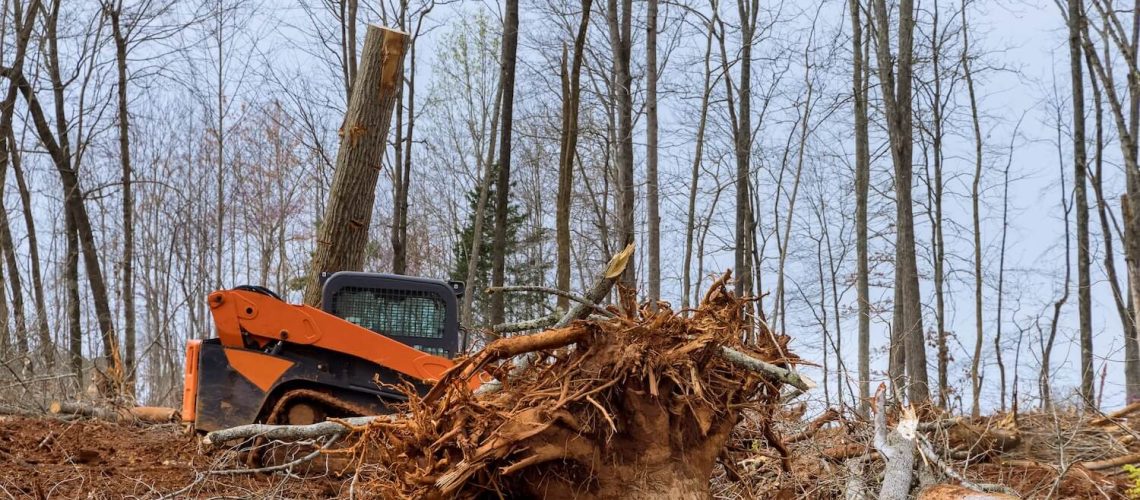Land development, whether for commercial construction, residential projects, or agricultural uses, requires a comprehensive understanding of the groundwork involved. Two critical processes that often come into play are land clearing and excavation. While they may sound similar and are both essential to preparing a site for development, they have distinct purposes and offer unique benefits. Understanding the differences between land clearing and excavation can help you choose the right approach for your project and maximize the long-term benefits of your investment.
1. What is Land Clearing?
Land clearing is the process of removing trees, bushes, rocks, stumps, and other vegetation or debris from a plot of land. It is the first step in preparing a site for construction, farming, or other uses. The primary objective of land clearing is to make the land usable and accessible for future development or to improve the overall health of the environment by managing overgrowth.
Methods of Land Clearing
Land clearing is done using various techniques depending on the size of the area and the nature of the vegetation or obstacles to be cleared:
- Brush Mulching: This method involves using specialized equipment to grind trees, shrubs, and vegetation into mulch. It’s an eco-friendly option that turns organic waste into nutrient-rich material that can enhance soil health. This method also helps reduce the need for extensive soil disruption and minimizes the environmental impact.
- Bulldozing: Bulldozers are used to push down trees and shrubs. This is ideal for large areas with dense vegetation but may disturb the soil significantly. It’s essential for creating level ground for further construction processes.
- Cut and Grind: For smaller plots, the cut and grind method is used, where vegetation is manually cut and removed or chipped into smaller pieces. This method is often employed in residential areas where precision and care are required to avoid damage to nearby structures.
- Controlled Burning: Though rarely used due to environmental concerns, controlled burns can clear large areas of land quickly by using fire to burn vegetation. However, it requires expert supervision and may release harmful pollutants into the air. This method is most suitable in regions where such practices are legally permissible and safe.
Benefits of Land Clearing
- Improved Land Usability: By removing unwanted trees, rocks, and stumps, the land becomes more accessible for farming, construction, or other activities. This makes it easier to plan and implement subsequent phases of a project.
- Enhanced Safety: Clearing land reduces the risk of wildfires by eliminating dry brush and dead trees, which are highly flammable. Furthermore, it helps prevent accidents related to obstructive vegetation.
- Pest Control: Overgrown areas are often home to pests, such as rodents, snakes, and insects. Land clearing eliminates their natural habitats, improving safety for people and pets. This is particularly crucial for residential areas or developments near natural habitats.
- Increased Property Value: A cleared plot of land is often more valuable, as it’s ready for construction or agricultural use. Potential buyers are more likely to invest in land that requires minimal initial work.
- Environmental Management: Properly managed land clearing promotes the growth of healthy plants and trees by removing invasive species or overcrowded vegetation. This can improve local biodiversity and ecosystem health.
2. What is Excavation?
Excavation involves the removal of soil, rock, and other materials to create a stable foundation for construction projects. This process typically follows land clearing but serves a different purpose, which is more structural in nature. Excavation services are essential for shaping the land to meet the specifications required for roads, buildings, or other infrastructure.
Types of Excavation Services
The method of excavation depends on the specific requirements of the project:
- Cut and Fill Excavation: This method involves cutting away portions of the land to achieve the desired elevation or grade. The cut material is often used to fill other parts of the site, reducing waste and ensuring efficient use of resources.
- Trenching: This type of excavation involves digging narrow and deep trenches, usually for installing utility lines such as pipes and cables. Trenching must be done with precision to avoid disrupting existing underground utilities.
- Basement Excavation: Excavation for a basement requires the removal of a large amount of earth to create a stable underground space. This type of excavation is typically more complex due to the need for proper drainage and structural support.
- Channel Excavation: This process is used for creating water channels or drainage systems by removing earth to direct the flow of water. Proper channel excavation can prevent flooding and manage stormwater runoff effectively.
Benefits of Excavation
- Stable Foundations: Excavation provides a stable base for buildings, ensuring that the construction is secure and safe for long-term use. A well-excavated site reduces the risk of structural failures and costly repairs.
- Site Grading: Proper excavation ensures that the land is graded correctly, which is essential for effective water drainage and flood prevention. Correct grading also contributes to the aesthetic appeal of the landscape.
- Improved Soil Conditions: In some cases, excavation allows for the removal of poor-quality soil and the replacement of better materials, improving the structural integrity of the site. This is particularly important in areas where expansive or unstable soils are present.
- Utility Installation: Excavation is critical for installing essential utilities like water, sewage, gas, and electrical lines underground. Proper planning and execution of excavation ensure that these utilities are installed safely and efficiently.
3. Key Differences Between Land Clearing and Excavation
While land clearing and excavation are both part of site preparation, they serve different purposes and involve distinct processes.
- Objective: The goal of land clearing is to remove vegetation and debris to make the land usable, while excavation focuses on shaping the earth to prepare for construction and utilities.
- Process: Land clearing primarily deals with surface-level obstructions such as trees, shrubs, and rocks, while excavation involves digging deeper into the soil to create foundations, trenches, or channels.
- Equipment: Land clearing requires specialized machinery like bulldozers, mulchers, and chainsaws, whereas excavation uses heavy-duty equipment such as backhoes, excavators, and trenchers. Understanding the equipment used is vital for estimating project costs and timelines.
- Environmental Impact: Land clearing has a more significant immediate impact on the environment by removing vegetation, though some methods, like mulching, can mitigate this. Excavation, on the other hand, alters the landscape and soil structure, which can affect drainage and soil stability.
- Timeline: Land clearing is generally a quicker process, depending on the size and density of the vegetation, while excavation can be a lengthier endeavor due to the precision required for creating stable foundations and ensuring proper site grading.
4. When is Land Clearing Needed?
Land clearing is necessary for a variety of projects, including:
- Agriculture: Farmers often clear land to create space for crops or livestock, making the soil more manageable for plowing and planting. This step can significantly improve yield by ensuring that crops have the best possible growing conditions.
- Construction: Land must be cleared before any construction project can begin to ensure that there are no obstacles like trees or boulders. This prepares the site for any subsequent excavation and foundation work.
- Landscaping: Homeowners may opt for land clearing to create a blank canvas for new landscaping projects or to maintain a manicured yard. It allows for the planning and implementation of new designs without the interference of existing vegetation.
- Fire Prevention: In fire-prone areas, land clearing is often recommended to remove combustible materials and reduce the risk of wildfires. This proactive measure can save lives and property.
5. When is Excavation Required?
Excavation is critical for many structural and utility-based projects, including:
- Building Foundations: Excavation is required to dig and stabilize foundations for homes, commercial buildings, and other structures. A properly excavated foundation is crucial for the longevity and safety of the building.
- Road Construction: Roads need to be excavated to ensure they are level and have proper drainage systems in place. This step is essential for the safety and durability of the road infrastructure.
- Utility Installation: Installing underground water, sewer, and electrical lines requires trenching and channel excavation. Correctly executed excavation minimizes the risk of damaging existing utilities and enhances overall project efficiency.
- Drainage Systems: Excavation is often used to create channels or modify the landscape to manage water runoff and prevent flooding. This is especially important in areas prone to heavy rainfall or stormwater runoff.
6. Choosing Between Land Clearing and Excavation
In most large-scale projects, both land clearing and excavation are necessary, but the sequence and extent will depend on the specific requirements. Here’s how to determine which service is needed:
- Project Scope: If your project only requires the removal of surface vegetation and debris, land clearing is sufficient. However, if you need to alter the landscape, create foundations, or install utilities, excavation is required.
- Budget: Land clearing is typically more affordable than excavation because it involves less specialized work. However, excavation becomes unavoidable in most construction projects, and it’s essential to budget for both services adequately.
- Environmental Considerations: If environmental preservation is a priority, opt for eco-friendly clearing methods such as mulching. In terms of excavation, minimizing soil disruption can help reduce erosion and protect local ecosystems.
- Future Developments: Consider your long-term plans for the land. If future developments are anticipated, you may need to plan for both clearing and excavation to ensure the land is adequately prepared for any upcoming projects.
7. The Benefits of Professional Services for Land Clearing and Excavation
Both land clearing and excavation require the right expertise, machinery, and experience to execute safely and effectively. Here’s why hiring professionals is crucial for either service:
- Expertise and Experience: Professional land clearing and excavation contractors understand the intricacies of both processes, ensuring that the work is completed safely, efficiently, and in compliance with local regulations.
- Safety: Heavy machinery and the potential hazards associated with land clearing and excavation make safety paramount. Professionals are trained to manage risks and adhere to safety standards, reducing the likelihood of accidents.
- Time Efficiency: Professionals have access to the right equipment and manpower, allowing them to complete the job faster than an untrained individual or team. This efficiency can save you time and money in the long run.
- Quality Assurance: Hiring experts ensures that the job is done correctly the first time, reducing the need for costly corrections or delays later in the project. Quality work lays the foundation for successful future developments.
Conclusion
Understanding the differences between land clearing and excavation is essential for anyone involved in land development. Both processes serve critical roles in preparing a site for construction or agriculture. While land clearing focuses on making the land usable by removing obstacles, excavation shapes the earth for structural support and utility installation. By recognizing the unique benefits of each, you can make informed decisions for your project and work with professionals to achieve the best results. Proper planning and execution of land clearing and excavation can lead to a successful foundation for your future endeavors, whether in construction, landscaping, or agriculture.

